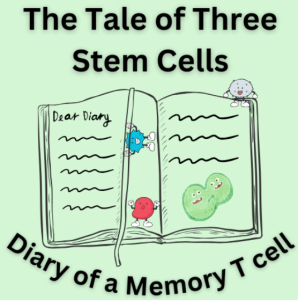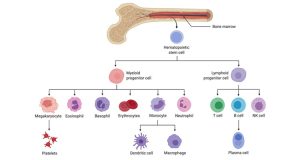Diary of a Memory T cell: A Tale of Three Stem Cells
By Ariane Tsai, C2ST Intern, University of Illinois Urbana-Champaign, Institute for Genomic Biology
In a world of modern science, few discoveries hold as much promise and intrigue as stem cells. With their remarkable ability to regenerate and repair tissues, stem cell therapy has revolutionized medical treatments ranging from liver disease to leukemia1. But have you ever wondered how these tiny yet potent entities take on these seemingly impossible tasks? Taking it one step further, how can two stem cells with the same characteristics regenerate different organs (i.e., one becoming a liver cell and another skin cell)? To understand how the cells go from stem cells to their final state, we will follow the journey of three stem cells in finding their way to fulfill their cellular fate.

Diary of a Memory T Cell
Entry Number: Day 150
From all my time working in the human body, I have encountered many cells, each unique yet interconnected. As I approach the end of my journey, I find myself reflecting on the path that led me here. As I think of my adolescent years, two of my best friends come to mind. Like every cell, we started out as embryonic stem cells with the ability to self-renew and differentiate into different cell types. Brimming with potential, I aspired to mature quickly and explore the body someday. Thus, our remarkable journey began as we engaged with our surrounding cells, absorbing all the essential nutrients and taking in many signals necessary for our future survival.
As fate granted me my wish, I successfully went through a process known as mesoderm specification, marking my transition into a hematopoietic stem cell (HSC). HSCs have the remarkable ability to differentiate into all types of blood cells (i.e., red blood cells, white blood cells, etc.)2. Our presence ensures the perpetual circulation of blood throughout the body, a function that, not to be self-important, supports life itself. It was no surprise that my two friends became HSCs like me. The three of us resided in the bone marrow together and soon became inseparable. Nevertheless, each of us harbored the dream of traveling beyond the confines of the bone marrow and witnessing the wonders of the body.
As time passed, the three of us started receiving intrinsic and extrinsic signals, nudging us toward distinct cellular lineages. While both my friends found passion in becoming frontline defenders of the body, I was drawn to preserving the body’s combat history through excellent record-keeping. Consequently, my friends transformed into myeloid progenitor cells, and I took on the role of a lymphoid progenitor cell. This stage of differentiation marked the commencement of our specialized training.

Despite diverging to our paths, we remained close and lived together in the bone marrow. After rigorous preparation, we finally achieved our destined roles through a process named hematopoiesis4. One of my friends became an erythrocyte, more commonly known as a red blood cell. Their job was to transport vital goods (such as oxygen, carbon dioxide, etc.) to tissues throughout the body. My other friend became a neutrophil (aka a white blood cell) and became the ultimate first responder. When a pathogen infiltrates the body, they are the first to be on-site, preventing the pathogens from causing any harm to the body. I also transformed and became a T cell, the body’s adaptive immune warrior! In this newfound identity, my role was memorizing parts of a pathogen (“antigen”) that invaded the body and coordinating with other immune cells for assistance.
The three of us went our separate ways, encountering each other sporadically while circulating in the bloodstream. After a period of dedicated service, I was promoted to a memory T cell by successfully memorizing a particular antigen that the body has encountered3. Equipped with this knowledge, I could provide immediate protection to the body by recognizing this pathogen faster than others. I lived a full life, a life longer than my red blood cell and neutrophil friends. Now as I approach the end of my life, I can’t help but think about them and commemorate them for the roles they played. Despite our infrequent encounters towards the end, we continued to work together, ensuring the body’s well-being. They inspired me to become the best version of myself. And for that, I will always be grateful.
References:
- https://www.ncbi.nlm.nih.gov/pmc/articles/PMC9357075/
- https://www.ncbi.nlm.nih.gov/pmc/articles/PMC7119209/
- https://www.ncbi.nlm.nih.gov/pmc/articles/PMC5371741/#:~:text=The%20lifespan%20of%20a%20human,of%20circulating%20memory%20T%20cells.
- https://icahn.mssm.edu/research/cardiovascular/focus/hematopoiesis#:~:text=Hematopoiesis%20is%20the%20blood%20cell,billion%20blood%20cells%20each%20day.